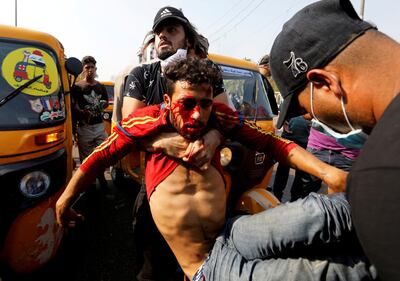As mass demonstrations sweep Iraq and Lebanon, conspiracy theories on pro-Iranian media outlets have gotten wilder.
The protest movement erupted in the two countries to deflect from the political crisis in Israel, announced the Arabic broadcast of Iran’s Al Alam television on Sunday.
The upheaval has been similar in that demonstrators want the ruling class in Beirut and Baghdad removed, without exception, threatening the grip of Iran’s Shiite militia clients.
Chief among them is Hezbollah and a plethora of non-state groups in Iraq, most notably the Badr Brigades which are originally the military arm of a Shiite opposition group to Saddam Hussein and which were founded in Tehran in the 1980s.
Badr and allied militias, together with Iraqi government forces, reportedly killed at least 250 demonstrators since protests started this month.
The Beirut government has shown less propensity to use violence, but this has been under outgoing leader Saad Hariri, who resigned on Tuesday.
Iran thinks the well-being of the two countries is dependent on maintaining what it touts as an anti-Israel “axis of resistance”, comprised mainly of paramilitary forces in Iraq, Lebanon, Syria and Yemen.
Beirut's Al Akhbar daily suggested that Israeli agents are directing the protests in Baghdad.
The newspaper said Israeli political analysts have been discussing discontent with Hezbollah in Lebanon to “weaken Lebanon’s internal front”, dismissing the fact that the analysts’ talk and publish mainly in Hebrew.

Former US president Barack Obama once suggested that Iraq and Lebanon are in Tehran’s "hood". But the protests are the biggest political challenge to Iran’s militia clients since they started to exert huge influence on state organisations in the two countries in the last decade.
Iran’s usually boisterous clerical rulers have remained largely silent about the upheaval taking place on the opposite sides of Syria, where Iran used Lebanese, Afghan and Iraqi Shiite militias to ensure the continuation of the Assad family rule.
Tehran came to President Bashar Al Assad’s rescue partly because the Assads have been co-operating with Iran since 1980 against Iraq, Israel and their own people.
While Iran has had to use, along with its militias, elite forces to prop the Syrian regime it has had no need to do so in Lebanon and Iraq.
The pro-Iranian militia are armed to the hilt, against largely unarmed protesters in Iraq, and a protest movement in Lebanon influenced by the country’s intelligentsia.
Lebanese lawyer Chibli Mallat, the writers Jihad Al Zain and Elias Khoury have been leading voices calling to preserve non-violent protest.
In Iraq, the intelligentsia has been all but destroyed by Saddam and by the rising power of Shiite clerics after he was toppled. Sunni clerics also contributed to fostering militancy among their own sect.
Saddam’s reign traumatised Iraq. The current prime minister, Adel Abdul Mahdi, appears to have taken little heed from that era, using shock troops to crush the protest movement and prevent what he describes as chaos and looting.
His words echoed Saddam, who described the Shiite masses who rose against him in a failed 1991 rebellion as “mobs”.
Lebanon went through a 15-year civil war and kept a sectarian system that Iraq partially copied. But the country has been spared the military dictatorships that swept many Arab countries after Jamal Abdel Nasser came to power in Egypt in the 1950s.
Abdel Nasser gave refuge to Saddam, as well as to other figures who defined the bloody history of their countries.
Mr Hariri sought not to use force against the demonstrators. But fears are rising that Hezbollah will use more force to cow the protest movement after Hezbollah's supporters on Tuesday ransacked protest grounds in Beirut.
The group is no stranger to violence, although its leaders claim that its weapons are to fight Israel, a claim that the Lebanese may be increasingly sceptical about.
An international court in The Hague indicted four Hezbollah members for the 2005 assassination of statesman Rafiq Hariri, father of the recently resigned prime minister.
In 2008, Hezbollah gunmen occupied large parts of Beirut, but that was after the younger Hariri tried to strip the militia of its communication network. Today, large numbers of Shiites are among the demonstrators.
Lebanon’s population is 6.1 million, with Sunnis and Shiites comprising a similar proportion of 28 per cent each. In Iraq, which has 40.1 million people, Shiites are a majority.
The late Iraqi politician Ahmad Chalabi said that close to $1 trillion (Dh3.672tn) has been looted in Iraq during the political system that followed Saddam, in which Chalabi had a major role.
In Lebanon, the figure might be in the tens of billions of dollars, not because of a lack of trying but largely because the country has not had the oil wealth.
The Iraqi authorities received a boost this week when US President Donald Trump praised them for contributing to actions that resulted in the killing of ISIS leader Abu Bakr Al Baghdadi.
Although Western countries condemned the crackdown in Iraq, they show no signs of taking practical steps to try and curb the government or Iran as the backer of the militias participating in the killings.
Europe and the US may have leverage over the next Lebanese government in that it needs Western aid to try and avert a financial meltdown.
But the response to the events in Iraq and the US drive for Middle East disentanglement do not signal international determination to help Lebanon avoid an Iraqi scenario where the authorities stand by or shed blood along with the Iran-backed militia.


